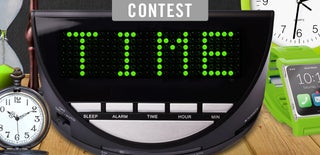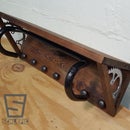Introduction: Wooden Pallet Wall Clock
Creating a wall clock from recycled wooden pallet boards is incredibly simple and looks fantastic. This Instructable documents the process.
*If you like this Instructable consider voting for it in the Time contest! As always, feel free to comment and/or share a picture of your own wall clock.
Step 1: Materials
Following is a high-level list of all the items you will need. I'll explain my methods more in each step, but there are numerous items that can be substituted into your project to suit your needs.
Required Items:
Clock Face: Pallet boards
Clock Movement: High torque clock movement
Clock Hands: Long clock hand set
Numbers/Indicators: Aluminum house numbers
Wall Hanger: Picture wire (with two screws)
Tools:
Hammer
Drill (with bits)
Wood glue
Optional:
Wood burner (for secondary hour markers)
Saw
Step 2: Clock Face
I had a plethora of pallet wood stacked in the garage so I meticulously sifted through the pile to find boards that were straight and created just the right mix of color and defects.
The boards were two feet long and about 3.5 inches wide. When I laid seven boards out mating the long sides, the result was almost a perfect two foot by two foot square. This was ideal because I wanted to have a square clock face and have an odd number of boards for visual appeal.
The clock face boards were held together by gluing two support boards vertically across the back of the clock face boards. I chose this method because I wanted to preserve the front of the clock face from new nail heads or glue in between the joints showing. I cut the support boards short to cover about half of the very top and bottom clock face boards because I didn't want anyone to see them while hanging on the wall.
I generously, but carefully, applied the glue to the support boards and left voids near the joints in the clock face to avoid excess glue being visible or oozing out on to the front face. Once both support boards were glued and laid in place, I checked to make sure nothing had shifted and stacked a few toolboxes worth of weight on top to apply pressure.
Step 3: Clock Movement
I had three criteria for selecting a movement: high torque, continuous movement and shaft length. I found a suitable clock movement on a popular DIY clock making website.
I needed a high torque movement because the clock hands I used were much longer and heavier than standard clock hands, which imposes higher torque on the shaft and would stress a standard movement.
When choosing a clock movement, I sought out one with a continuous drive motor to avoid having to listen to it "click" every second.
I made sure the clock movement I purchased had a shaft longer than the thickness of the pallet board so that all of the clock hands could be installed.
Since the clock movement was only friction fit into the center hole, I glued a popsicle stick to the back of the clock to prevent the movement motor and battery from accidentally rotating.This step was optional for me because I tested the clock on the wall without the popsicle stick and didn't have any movement rotation.
Step 4: Numbers/Indicators
At the beginning of this project, I wasn't quite sure what I would use for numbers on the clock face. Then it hit me that aluminum house numbers (for use on homes or mailboxes) could work. There were two or three different sizes and styles at my local hardware store and it seemed that only the largest option would work with the style of my clock, but the numbers were too large to mark every hour. Then, I realized the clock would look great marking only the hours of 12, 3, 6, and 9. The size of the numbers was perfect for this application and I was even able to find some that already came in black.
Since I changed my design plan to only mark every three hours, I had a decision to make; to mark the remaining hours in some way or just leave the clock face blank. After careful thought, I decided to use my wood burner to burn a small circle (relative to the size of the numbers) in the location of the other hours. This seemed to be a good compromise of the two options. On one hand the location of each hour is clearly marked for reference, but on the other hand the simple style of the clock is preserved by only representing the other hours with a small, basic shape (a circle).
Using a straight edge, I found the center by making an X across the diagonals of the clock face. This point was used to denote the center hole where the clock movement shaft would emerge from.
I used the center hole and edges as a reference to mark the locations of the numbers and then nailed them into place. Using a carpenter's square, I created a template with a 30 degree angle to mark the location of the dots with reference to the center hole and burned them in.
Step 5: Clock Hands
The style of the clock hands was critical to fit in with the simple and rustic style of the clock face and numbers. The length of the hands was also important because of the large size of my clock face. I was able to find a set I liked with a 16 inch minute hand and 12 inch hour hand from the same popular DIY clock making website. The set I purchased came with a second hand (as most do), but I chose not to use it because I felt the style of the clock looked better without it. To install, I simply slid on the hour hand, the minute hand and then screwed in the top cap.
Step 6: Wall Hanger
As far as large clocks go, my clock is relatively thin (the movement is actually the thickest piece) and hanging it flush on the wall was a bit of a challenge. Drilling a hole through the clock face was absolutely out of the question and I didn't have access to a router to notch a groove so I devised a way to use standard picture hanging wire to hold the clock up. I drilled a small screw on the inside of each support board (parallel to the clock face boards) so that the heads were pointing at each other. The screws were left with the head raised to allow for the wire to be wrapped around it. I decided to leave a fair amount of slack in the wire so that the clock would be easier to level.
Step 7: Finale
Hang and watch the time fly by!

Runner Up in the
Time Contest













